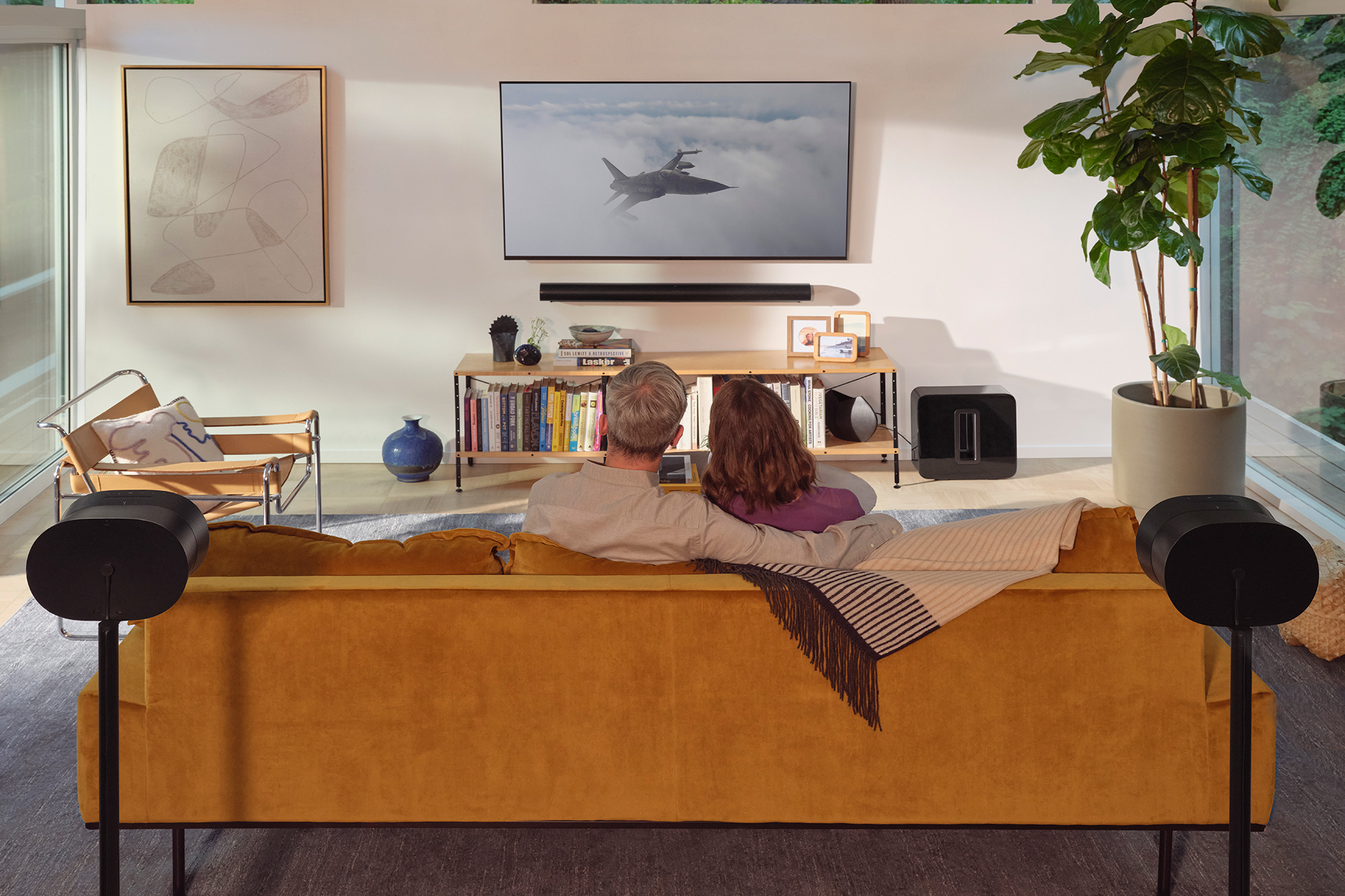

We may earn revenue from the products available on this page and participate in affiliate programs. Learn more ›
Sonos has revealed the Era 100 and Era 300, its first non-portable smart speakers in several years. But, despite their stationary form factors, each speaker is focused on transportive acoustics. Acknowledging immersive audio as the shape of sound to come, the new speakers are designed for more expansive playback, whether standalone in a whole-home system or integrated into a Sonos home theater suite. Let’s take a look at what’s coming later this month.
The Era 100
Sonos Era 100
The Sonos Era 100 (shown in white above) is effectively a replacement for (what they’re calling a “remastering of”) the second-generation One, its entry-level mains-powered home speaker. The Era 100 is about half an inch taller and half a pound heavier, and it has an entirely new—but still familiar—industrial design. The biggest external change is the inclusion of a shallow, touch-sensitive trench along the other controls on top of the speaker, which makes sliding to change its volume more intuitive than the line of dots found on the One. This is especially a win on the accessibility front, making the Sonos Era 100 easier to operate without sight.
Sonos took the most popular features of the second-generation One—especially support for Alexa and Sonos Voice Control, Apple’s AirPlay 2, Trueplay auto-calibration, and a fully featured app with streaming sources and adjustable EQ—and augmented Wi-Fi 6 with the highly requested Bluetooth 5.0 (previously only featured on the Roam and Move portable speakers). And, if privacy is a major concern, you can use a physical toggle to disconnect power to the far-field microphone array.
The Era 100’s updated, rounder design is nice. Still, you’re primarily going to buy a smart speaker for its sound. Following a brief audition in a New York showroom, I was immediately struck by how Sonos has delivered some notable improvements over the second-generation One without radically altering the speaker’s shape and size. This new speaker can play music in stereo courtesy of two angled tweeters and a larger midrange woofer with custom waveguide. You can still pair two Era 100s together wirelessly for additional separation (or with a Sonos Dolby Atmos soundbar, such as the Arc, to provide rear Left/Right channels). Still, Sonos has widened the soundstage from a single source, and a trio of class-D digital amplifiers—in addition to custom, in-house tuning—produced a surprisingly convincing off-axis response and an impressive amount of low-end in my first impressions (more to come at the end of March). This makes even a single Era 100 a compact complement to the Works With Sonos network-enabled Victrola Stream Carbon Turntable (which we’re reviewing soon).
Already invested in a more traditionally tethered turntable? Don’t count the Era 100 out, though Sonos has also taken a novel, if not controversial, approach to wired connectivity. If you turn the Era 100 around, you’ll see a USB-C port, which can be turned into an Aux-in or Ethernet port with an optional Combo Adapter. We always applaud additional connectivity options—especially extending the Era 100’s usability by literal decades—but wish the adapters came in the box. Speaking of sustainability, Sonos has designed the Era 100 and Era 300 to be easily repairable, replacing adhesives with screws wherever possible to make it easier for technicians to get into the speakers to address common issues. The Era 100 costs $249 and will be in stores March 28 (though it can be preordered directly from Sonos now).
The Era 300
The Era 100, while impressive, is still a replacement for an existing product in the company’s portfolio. The Era 300, meanwhile, is a completely different story reimagined from the ground up. It doesn’t supersede any speakers in the Sonos Play series but introduces a distinctive architecture specifically for multidirectional audio. The Era 300 has all the smart features of its smaller sibling—including optional voice control, the USB-C Line-In port, the capacitive volume well, Bluetooth 5.0, repairability, etc.—but there’s a lot more going on under the hourglass hood (as shown above).
Sonos has outfitted the Era 300 with four tweeters and two woofers powered by six class-D amplifiers. The configuration’s contours allow it to play Dolby Atmos tracks—initially from Amazon Music, but also from Apple Music in a March 28 firmware update for Era 300, Arc, and Beam (Gen. 2)—from a single speaker. This is possible, in part, because of the speaker’s unique silhouette, which allowed the engineers to include an up-firing tweeter within its precisely calculated proportions. Non-Atmos tracks will play in true stereo, too. If you already have a Sonos Arc (and, optimally, a Sonos Sub or Sub Mini), adding a pair of the Era 300 speakers as rear speakers will create the best home theater system the company has ever offered. When briefly demoed (admittedly in a carefully cultivated environment), the Era 300 was expressive, unfurling a corrugated yet firmly centered rendering of tracks mixed with multiple angles. Punchy, billowing, articulate—adjectives cued up quickly with each track.

The Era 300’s unique shape clocks in at 6.3-inches tall, 10.24-inches wide, and 7.28-inches deep, and weighs in at 9.85 pounds. It requires more space than many smart speakers—Bowers & Wilkins’ Zeppelin is a notable exception—but Sonos has packed the Era 300, which also ships March 28 and can be preordered direct today, with a lot of new hardware. These innovative features are commensurate with the Era 300’s $449 price tag, which brings the price of a pair to just under $1,000 with sales tax. We’ll declare whether the juice is worth the squeeze later this month in a full review testing the Era 300’s multi-channel dispersion by itself (versus the 2nd-gen. HomePod, naturally) and as part of the Arc ecosystem.


